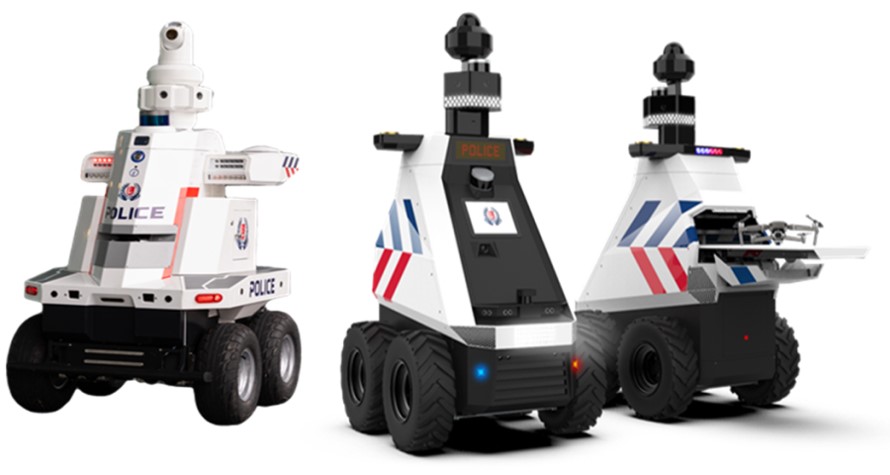 (Photo: SPF)
(Photo: SPF)
It’s not an R2D2 or C3PO, with endearing human emotions and human-like dexterity. But the humble invention of the M.A.T.A.R. is no less of a force to be reckoned with – for HTX engineers, our local police, and foreign workers at the dormitory.
When we think of robots, we invariably conjure up images of high-powered bots like those in Star Wars and Transformers. We are drawn to robots that can interact with humans like any other human. But beyond these imaginary characters that we play with and are entertained by, robots in real life serve human needs, offering newfound conveniences and improving our lives in myriad ways. At a crucial time like the current COVID-19 situation, the pressing need to count on robots to help protect and save lives is even more felt.
That is where HTX’s Multi-purpose All-Terrain Autonomous Robots (M.A.T.A.R.) came in very useful. With more Government Quarantine Facilities (GQF) and isolation facilities being set up during this period, reinforcements in policing the living quarters to enhance their security are much needed. This led to M.A.T.A.R.s being deployed by HTX and the Singapore Police Force (SPF) to help with foot patrol and project police presence at a GQF and a foreign worker dormitory.
The M.A.T.A.R.s’ autonomous patrolling capability has not only enhanced the efficiency of police ground ops, but also helped to reduce exposure of frontline officers, thus keeping them safe. The M.A.T.A.R.s also made the living quarters safer for residents by helping to ensure safe distancing, in place of human officers.
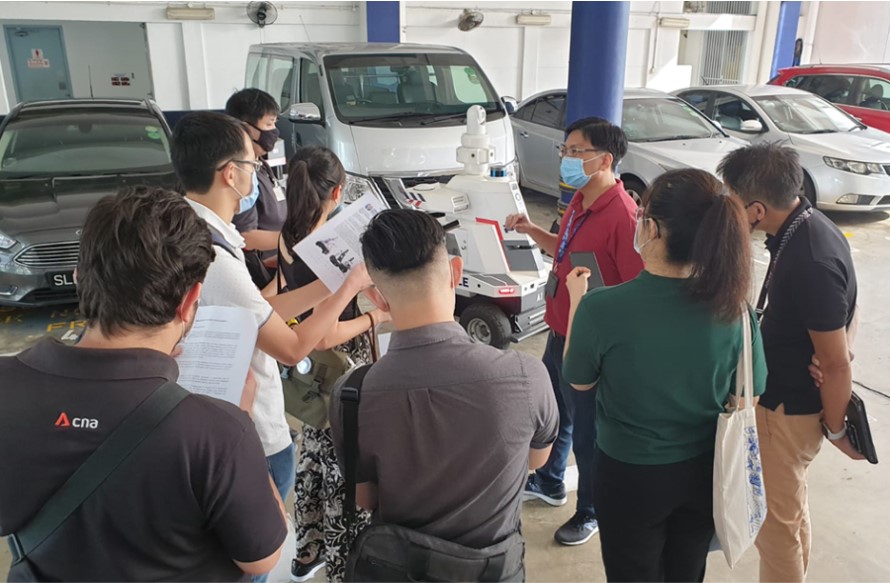 Ong Ka Hing, Deputy Director (Ground Robotics), RAUS CoE, sharing with the media about M.A.T.A.R. (Photo: HTX)
Ong Ka Hing, Deputy Director (Ground Robotics), RAUS CoE, sharing with the media about M.A.T.A.R. (Photo: HTX)
Before the COVID-19 situation, M.A.T.A.R. has also been deployed to augment police operations at several major security events, such as the National Day Parade 2019, Marina Bay Countdown 2020 and Chingay 2020.
The force multiplier team’s persistence with M.A.T.A.R. is leading on wider applications and more advanced technologies. And the more M.A.T.A.R.’s capabilities are being employed in ground operations, the more able, informed and inspired is the team in deepening its relevance to improve, protect, even save lives.
Recognising its Benefits
Recounting the scenario when HTX RAUS Engineer Goh Boon Kiat first arrived at the dormitory where the M.A.T.A.R.s were deployed, he said, “It felt surreal to see what used to be a carpark and basketball court converted into an ops area with tentage and barricades. It was a stark reminder of the gravity of the COVID-19 situation.”
He described how the dorm was segregated into zones – Red for residential area, Green for rest area, the command centre and SPF room where M.A.T.A.R. was housed. He said, after the route mapping for M.A.T.A.R. was done, there was no need any more for frontline officers to enter the Red Zone. All monitoring can be done from the Green Zone, and the robot will automatically navigate out of the Red Zone once its shift ends, for disinfection and return to charging station.
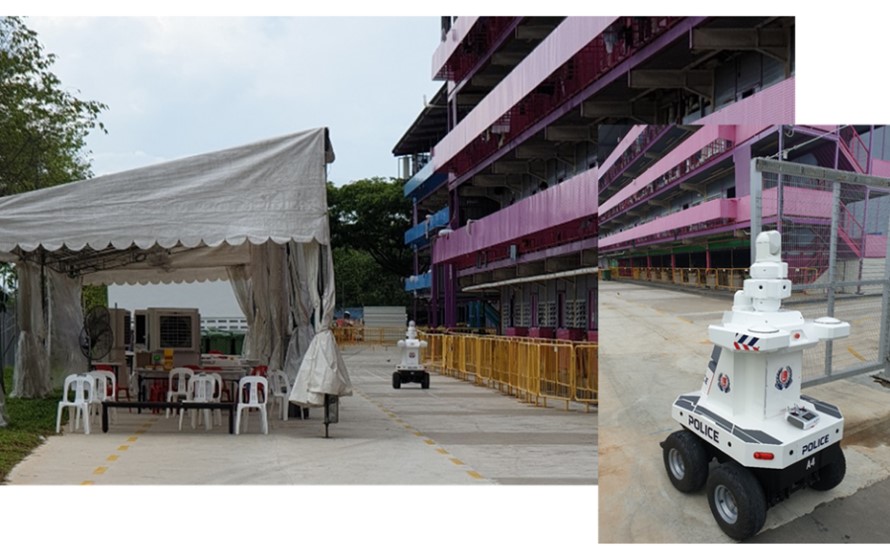 M.A.T.A.R. on patrol at a foreign workers dormitory (Photo: HTX)
M.A.T.A.R. on patrol at a foreign workers dormitory (Photo: HTX)
M.A.T.A.R.’s deployment freed police officers of manual repetitive patrolling tasks, and substituted them in entering risky zones and performing risky operations. It can also respond to situations quickly, unlike human officers who first have to don full personal protective gear before heading onsite to address ground issues.
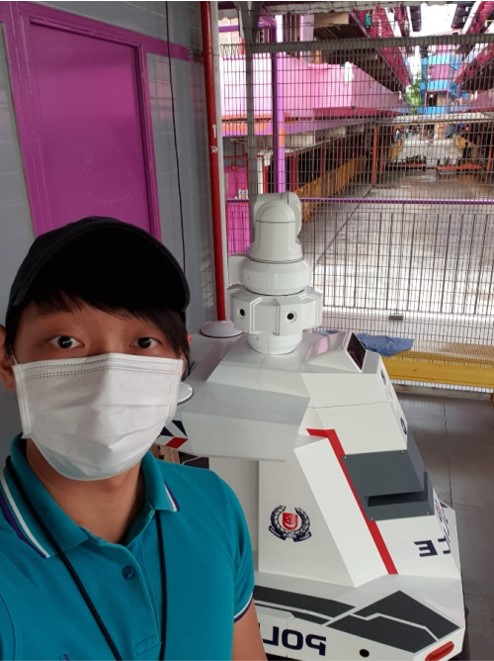 Goh Boon Kiat, RAUS Engineer, with M.A.T.A.R. at its charging station (Photo: HTX)
Goh Boon Kiat, RAUS Engineer, with M.A.T.A.R. at its charging station (Photo: HTX)
Said Boon Kiat, “While we were doing some modifications onsite at the rest zone, we overheard the frontline officers having casual conversations about their family’s concerns over their well-being and children’s schoolwork. It impressed upon me that, although the mission of the robot may sound mundane, the benefits it brings are very real and extend beyond protecting our frontline officers, to their loved ones too."
It was heartening too for HTX’s partners – ST Engineering and A*STAR, who had played an instrumental role in M.A.T.A.R.’s deployment and development – to see M.A.T.A.R. being used for critical missions during the COVID-19 period.
The team at ST Engineering Land Systems said, “It’s a satisfying moment to see M.A.T.A.R. deployed in field where it extended HTX/SPF ground presence into areas not safe for security personnel to patrol and in times security manpower is stretched.”
A*STAR partners were similarly glad to see that their enabling technologies have contributed to the nation’s fight against COVID-19 during this difficult time. “We will continue to work closely with public sector agencies such as HTX, SPF and local companies to create innovative solutions that can help boost productivity and work processes,” they said.
Bridging Distances and Impacting Lives
M.A.T.A.R.’s deployment is yet another demonstration of how technology enhances and impacts lives. Helped by their collaboration with industry and research partners, HTX engineers are close to fully operationalising M.A.T.A.R. for police operations beyond COVID-19.
“Within the team, there is always a sense of camaraderie, driven by a common goal of wanting the Home Team to succeed. There is a lot of enthusiasm and excitement about technological developments, even those that are not within our individual areas, resulting in our chat group sometimes being flooded with articles. MHA and HTX senior management have also been very supportive of our initiative to lean forward in supporting SPF operations,” shared Ka Hing.
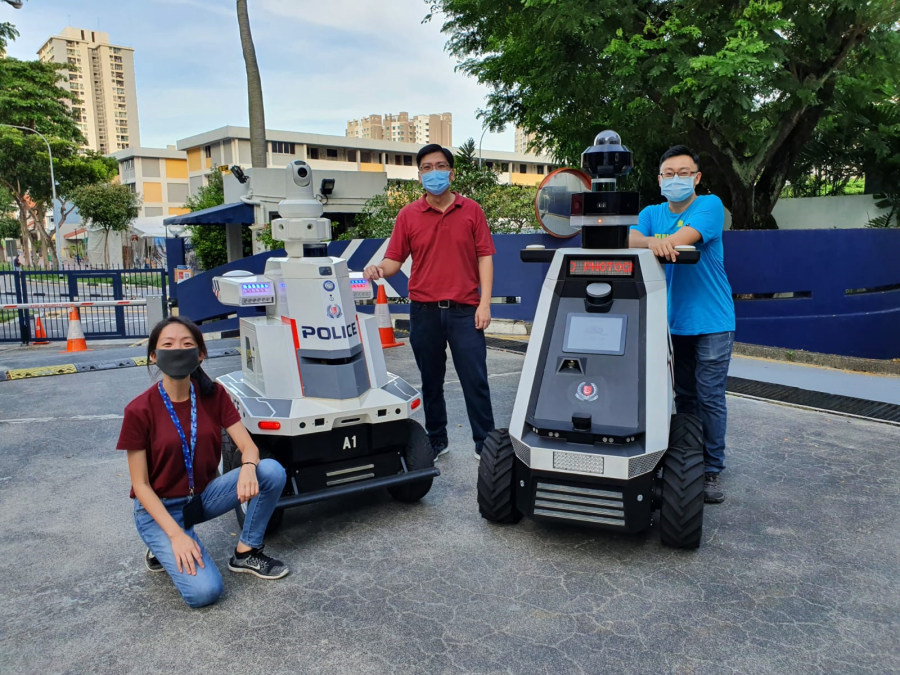 HTX RAUS officers who are part of the team working on M.A.T.A.R.: (from left) Engineer Vanessia Choo, Deputy Director Ka Hing, and Senior Assistant Director Lee Guoming (Photo: HTX)
HTX RAUS officers who are part of the team working on M.A.T.A.R.: (from left) Engineer Vanessia Choo, Deputy Director Ka Hing, and Senior Assistant Director Lee Guoming (Photo: HTX)
Although working and living with robots is not new, it is no less wow. The conveniences and empowerment we enjoy with automation may seem simple and common, but they are not so at all. Behind the innovations are likely countless tries and efforts from many resilient and brilliant minds, behind the scenes and unnoticed in the public eye. But the human will and connection is nonetheless very present in doing the work of bridging distances and making a difference to lives through exploiting technologies.
M.A.T.A.R. patrolling the foreign workers dormitory (Video: SPF)
Realising the Potential of M.A.T.A.R.
The use of M.A.T.A.R. today exceeded expectations of the HTX engineers who first conceived it while in the Ministry of Home Affairs (MHA) in early 2016. The project almost could not take off, as their peers then questioned the need for such a robot, with some seeing it as a potential white elephant. But having management’s support, they nevertheless pushed on with the effort, believing that it would result in something unique and useful for the Home Team.
Their confidence was boosted with M.A.T.A.R.’s first launch in 2018, when they received favourable responses and even queries from other countries to learn more about the robot. The experience of building M.A.T.A.R. from scratch – with a common framework architecture that allows integration of several key robotics technology building blocks (such as Simultaneous Localisation and Mapping, Obstacle Detection Obstacle Avoidance, path planning, road segmentation, cooperative behaviours), coupled with specific payload capabilities – was rewarding and valuable for further applications. With the robotics software developed, the team could apply it subsequently to multiple Home Team operations, for example perimeter surveillance, autonomous equipment transporter, and even augment Rover-X for search and rescue missions.
Although they already had a workable prototype of the M.A.T.A.R. in 2018, the engineers didn’t stop trying to improve on its capabilities. They wanted more, and had an insatiable desire to make the M.A.T.A.R. even better. In late 2018, they came up with the idea of incorporating a tethered drone as part of M.A.T.A.R. This would mean a quantum leap in M.A.T.A.R.’s capabilities, as having an aerial picture would give SPF a real advantage and improved situational awareness of the ground. That was a tough endeavor though – the timeline was short and budget was tight. But they eventually pulled it off in 2019, together with project partners.
Today, M.A.T.A.R. provides a 360-degree video feed to Police Command Centres, has audio communication functions for relaying instructions, is autonomous and can be controlled remotely.
Force Multiplier Effect
M.A.T.A.R.s are currently being deployed for 24/7 tireless patrol at a foreign workers dormitory. “M.A.T.A.R.’s deployment to help augment police ground ops during the COVID-19 period, is a small but significant step for SPF, and a giant leap for HTX – in using robotics technology in real-life ops as a force multiplier,” said Deputy Director (Ground Robotics) Ong Ka Hing, who is the Technical Advisor of this deployment. Currently with HTX’s Robotics, Automation & Unmanned Systems (RAUS) Centre of Expertise, Ka Hing has more than six years of engineering experience at the MHA. He is also the technical lead in other HTX key robotics projects such as Rover-X, the search and rescue robotic dog, and the Automated Passenger In-car Clearance System (APICS).
Being one of the key people who built M.A.T.A.R. from scratch and worked on its enhancement through the years, he said, “It is gratifying to see the idea that the team conceived way back in 2016 come to fruition and be deployed for COVID-19 operations. We envisage that this would be the beginning of an exciting journey for HTX, and that there will be more to come.
“With eventual full-scale deployment of M.A.T.A.R., SPF and other Home Team Departments would be able to augment their manpower, thereby increasing their operational capacity and agility to meet the new challenges faced in future operations. The use of M.A.T.A.R. for SPF’s COVID-19 operations has helped the adoption of robotics and given SPF a glimpse into the potential of M.A.T.A.R.”.

